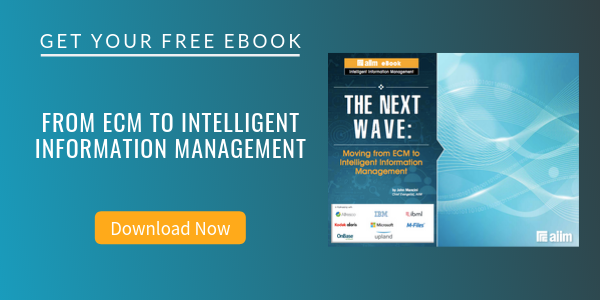
7 Tips to Make Information Chaos Worse in Your Organization
Enterprise Content Management (ECM) | Document Management | Intelligent Information Management (IIM)
The possibilities for more information chaos surround us. Content is proliferating at geometric rates, and organizations and the people who work in them are struggling with massive amounts of information overload. The sheer volume of content and data entering our organizations is growing in complexity, volume, and variety.
That would all be complicated enough on its own. But what are organizations doing – often with the best of intentions – to actually make things WORSE? Here are my top seven tips.
1. Assume that your existing process platforms – like your ERP (Enterprise Resource Planning), Human Resource Information Systems or Accounts Payable system – can just handle everything.
The reality: This approach typically creates a single point of access for documents – documents can only be retrieved within the application into which they were scanned. Not only does the Finance system have its own scanning app, so does HR and other key business systems. This then leads to licensing issues, another workflow engine, and a lack of records retention. Finding documents related to one another becomes very difficult. The scanning process becomes very slow and can only be done by expensive high pay-grade knowledge workers.
2. Assume your nephew can probably create the online forms you need because he is pretty good at technology.
The reality: Capturing data on the web is pretty easy, and odds are just about anyone with even a passing knowledge of technology can figure out how to do so. But what are you actually going to DO with the data once you’ve captured it? It’s one thing to grab data via a web form, but quite another to actually put it to work. Using e-forms to capture information, standardize it, rationalize it, and integrate it into a business process in a predictable and auditable way is not a task to leave to your nephew.
3. “Go paperless” by just using your copier to scan to a folder on a shared drive.
The reality: Scanning to a folder from an MFP or copier is pretty easy and almost anyone can figure out how to do it. But similar to tip #2, the question then is, “Now what?” Just scanning a piece of paper, creating an image of it, and sticking that image on a shared drive creates only marginal value. Odds are, that same document will likely be printed later, the information on it manually entered into a business process, and then it will be scanned again multiple times (Scan-Print-Lather-Repeat). Why? Because you haven’t changed how the information on that piece of paper is actually entered into a process. Automatically extracting information and data from a scan and using it to drive a business process is what “going paperless” is really all about.
4. Go cheap when it comes to getting outside expert help.
The reality: Business processes are what makes your business run. And paper-clogged inefficiencies are likely the single greatest source of unclaimed profit in your organization. As the Midas ad says, “you can pay me now or pay me later.” Automating processes requires someone who understands both the process and how to manage the tons of information connected with that process.
5. Tackle ALL content and processes at once.
The reality: A common failure point once an organization realizes the many sources of process pain and inefficiency in their organization is to try to fix everything all at once. In the process, they often wind up worse than where they started, because at least with manual processes, they had some idea -- albeit a flawed idea -- of how to push work out the door. Most forward-looking organizations have a strategy for how they will manage organizational content, but they tackle automation projects one at a time.
6. Let IT handle this; business people don’t have time.
The reality: IT people are great people. Really. But most are focused more on the T (technology) part of their job than the I (information) part. Certainly IT needs to be involved and provide the adult supervision for process reinvention and transformation projects. But it’s the business that actually understands how a process works, and the business has to drive automation projects. Not as an afterthought – “Let’s do some user testing and training once IT rolls this thing out” – but from the very start.
7. Allow “the business” to buy lots and lots of unconnected single application SaaS solutions.
The reality: I am a big advocate for SaaS-based enterprise solutions. Beginning with Salesforce, they have revolutionized how we buy and implement enterprise technology. The good news is that many enterprise solutions that were previously thought of as on-premise solutions requiring long purchase and implementation cycles, with all the money paid up front, can now be bought in the cloud, implemented quickly, and paid for as an annuity. That’s also the bad news, because if there is not adult supervision in this process and an appreciation that organizations need a content and document “layer” that cuts across all of these SaaS processes, they will wind up down the road with a set of information silos that puts the information silos in Tip #1 to shame.
About John Mancini
John Mancini is the President of Content Results, LLC and the Past President of AIIM. He is a well-known author, speaker, and advisor on information management, digital transformation and intelligent automation. John is a frequent keynote speaker and author of more than 30 eBooks on a variety of topics. He can be found on Twitter, LinkedIn and Facebook as jmancini77. Recent keynote topics include: The Stairway to Digital Transformation Navigating Disruptive Waters — 4 Things You Need to Know to Build Your Digital Transformation Strategy Getting Ahead of the Digital Transformation Curve Viewing Information Management Through a New Lens Digital Disruption: 6 Strategies to Avoid Being “Blockbustered” Specialties: Keynote speaker and writer on AI, RPA, intelligent Information Management, Intelligent Automation and Digital Transformation. Consensus-building with Boards to create strategic focus, action, and accountability. Extensive public speaking and public relations work Conversant and experienced in major technology issues and trends. Expert on inbound and content marketing, particularly in an association environment and on the Hubspot platform. John is a Phi Beta Kappa graduate of the College of William and Mary, and holds an M.A. in Public Policy from the Woodrow Wilson School at Princeton University.



